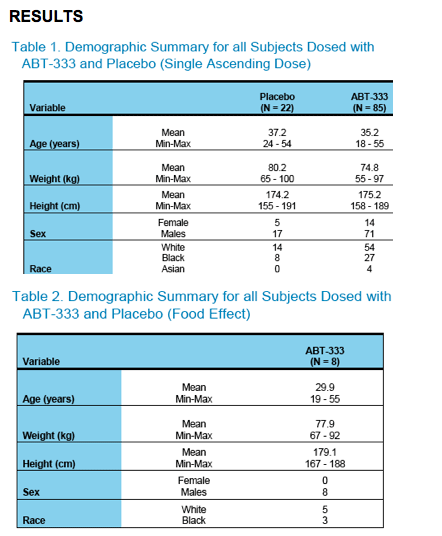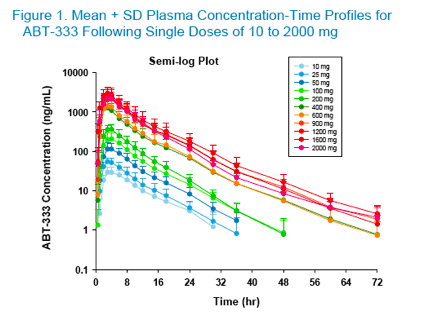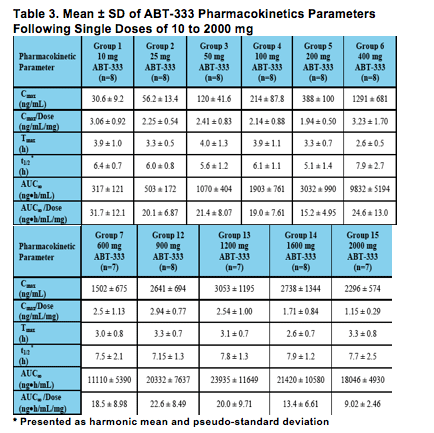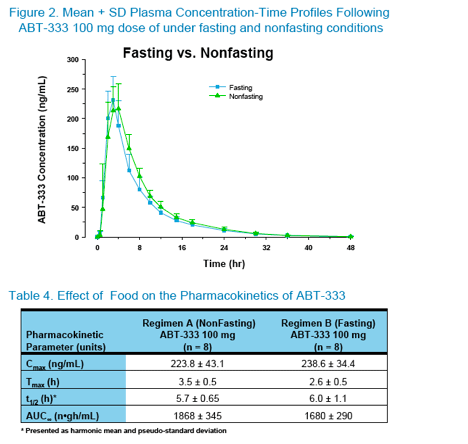 |
 |
 |
| |
Pharmacokinetics and Tolerability of the HCV Polymerase Inhibitor ABT-333 Following Single Ascending Doses in Healthy Adult Volunteers
|
| |
| |
Reported by Jules Levin
44th Annual Meeting of the European Association for the Study of the Liver ( EASL), Copenhagen, Denmark, 22-26 April 2009
Rajeev Menon*, Daniel Cohen, Adel Nada, Emily Olson Dumas, Yi-Lin Chiu, Thomas Podsadecki, Walid Awni, Barry Bernstein,
Cheri Enders Klein
Abbott Laboratories, Abbott Park, IL
AUTHOR CONCLUSIONS
ABT-333 was safe and well tolerated at doses ranging from 10 mg to 2000 mg.
Pharmacokinetics of single ascending doses from 10 to 1200 mg were dose proportional.
The mean t1/2 for ABT-333 ranged from 5-8 hours.
Food had minimal effect on the bioavailability of ABT-333.
Safety Results
ABT-333 was safe and well tolerated across all dose groups ranging from 10 to 2000 mg (N = 85).
The most frequently reported adverse events were nausea (N = 7), abdominal pain/discomfort (N = 5), and headache (N = 4).
No association between the character or frequency of adverse events or laboratory abnormalities and ABT-333 dose was observed.
Adverse events were generally mild in severity.
There were no severe or serious adverse events (SAEs).
There were no clinically significant laboratory abnormalities or ECG changes.
ABSTRACT
Background and Aims: ABT-333 is a novel non-nucleoside NS5B polymerase inhibitor being developed for the treatment of HCV genotype 1 infection. The objectives of this study were to evaluate the safety, tolerability and pharmacokinetics (PK) of escalating, single, oral doses of ABT-333 and to determine the effect of food on the PK of ABT-333 in healthy subjects.
Methods: The double-blind, placebo-controlled, single-ascending dose (10 to 2000 mg) portion of this study was conducted in 11 sequential groups. In each dose group, healthy adult subjects were randomized to receive oral doses of either ABT-333 (8) or Placebo (2) under nonfasting conditions. The single-dose, open-label, food-effect portion of this study dosed 8 healthy adult subjects with 100 mg ABT-333 under fasting and nonfasting conditions in a 2-period crossover design. Plasma samples were collected for up to 72 hours after dosing for pharmacokinetic analyses. Safety and tolerability were monitored throughout the study.
Results: Maximum plasma concentrations (Cmax) of ABT-333 occurred at approximately 3 hours post-dose. The mean half-life (t1/2) was 5 to 8 hours. The Cmax and area under the plasma concentration-time curve (AUC) increased proportionally from 10 to 1200 mg.
Food did not impact the Cmax and AUC of ABT-333. Single doses of ABT-333 up to the maximum dose tested, 2000 mg, were well tolerated. There were no clinically significant dose-related changes from baseline in laboratory values, vital signs, or ECG recordings.
Conclusions: The PK of ABT-333 increased in a dose-proportional fashion from 10 to 1200 mg. Food did not impact the Cmax and AUC of ABT-333. ABT-333 was well tolerated up to the maximum dose tested, 2000 mg.
Note: As no safety or tolerability issues were identified on dosing up to 1200 mg, additional doses (1600 mg and 2000 mg) were added to the study following abstract submission.
INTRODUCTION
ABT-333 is a novel non-nucleoside NS5B polymerase inhibitor being developed for the treatment of HCV genotype 1 infection.
ABT-333 exhibits highly potent and selective activity against genotype 1a and 1b HCV polymerases [Poster Number: 955].
OBJECTIVES
Assess the safety, tolerability, and pharmacokinetics of escalating, single, oral doses of ABT-333 under nonfasting conditions in healthy adult subjects.
Evaluate the effect of food on the pharmacokinetics of ABT-333 in healthy adult subjects.
METHODS
Study Design
· This was a Phase 1, single-dose, randomized, placebo-controlled, parallel group study conducted according to a sequential design.
· The protocol was reviewed and approved by an Independent Review Board prior to the start of the study. All subjects who participated in the study gave written informed consent prior to starting any study procedures.
· Adult male and female subjects in general good health were selected to participate in the study according to the selection criteria. In the single ascending dose portion of the study, 10 subjects in each group were randomized in a 4:1 fashion to receive single oral doses of ABT-333 or matching placebo following a moderate-fat meal. Safety, tolerability, and preliminary pharmacokinetic results were assessed in each group prior to the start of the next group. The doses administered in the single ascending dose portion of the study ranged from 10 to 2000 mg. In the food effect portion of the study, 8 subjects were administered ABT-333 100 mg with and without food in a randomized cross-over design.
Pharmacokinetic Assessments
· Complete pharmacokinetic profiles for ABT-333 were drawn prior to dosing and up to 72 hours after dosing.
· ABT-333 concentrations were determined by a validated high performance liquid chromatography tandem mass spectroscopy method (HPLC-MS/MS) with a lower limit of quantitation of 1 ng/mL.
· Pharmacokinetic parameters were estimated using noncompartmental methods in WinNonlin Version 5.2.1 (Pharsight, Mountain View, CA).
Safety and Tolerability Assessments
· Safety and tolerability assessments included physical examination, vital sign measurements and clinical laboratory tests.
· 12-lead Electrocardiogram (ECG) were recorded in triplicate at multiple time-points before and after dosing. Twelve lead continuous cardiac monitoring was also conducted on all subjects.
· Adverse events were monitored throughout the study.
Statistical Methods
· Statistical analyses were conducted using SAS version 9.13 ( Cary, NC).
· Dose proportionality analysis was conducted on dose-normalized and log-transformed Cmax and AUC values.
· The effect of food on ABT-333 pharmacokinetics was assessed by comparing log-transformed Cmax and AUC values with and without food using analysis of variance (ANOVA). For Cmax and AUC, ratio of geometric means between nonfasting and
fasting regimens was calculated to quantify the effect of food on ABT-333.
· Adverse events were coded using the Medical Dictionary for Regulatory Activities (MedDRA 11.1) The number and percentage of subjects having treatment-emergent adverse events were tabulated with a breakdown by ABT-333 regimen.

Figure 1 displays the average concentration time profiles for ABT-333 for doses 10 to 2000 mg. Mean pharmacokinetic parameters are shown in Table 3.
Cmax and AUC values for ABT-333 increased with increasing dose from 10 mg to 1200 mg in a dose-proportional fashion. Increasing doses to 1600 mg and 2000 mg did not result in further increases in exposure.
Mean Tmax values were 3-4 hours across all dose groups.
Mean t1/2 across doses ranged from 5 to 8 hours.


Figure 2 displays the average concentration time profiles for ABT-333 100 mg under fasting and nonfasting conditions. The mean pharmacokinetic parameters, ratios of geometric means and 95% confidence intervals for the ratios are given in Table 4.
ABT-333 Cmax and AUC values were comparable under fasting conditions and when ABT-333 was administered with a moderate-fat meal.

For Cmax and AUC, the ratios of the geometric means for nonfasting vs. fasting regimens were approximately 1.
Safety Results
ABT-333 was safe and well tolerated across all dose groups ranging from 10 to 2000 mg (N = 85).
The most frequently reported adverse events were nausea (N = 7), abdominal pain/discomfort (N = 5), and headache (N = 4).
No association between the character or frequency of adverse events or laboratory abnormalities and ABT-333 dose was observed.
Adverse events were generally mild in severity.
There were no severe or serious adverse events (SAEs).
There were no clinically significant laboratory abnormalities or ECG changes.
Acknowledgements
· The staff at Abbott Clinical Pharmacology Research Unit
· Other individuals contributing to the conduct of the study and technical analysis including Dilraj Sidhu, Theresa Marsh, Sara Gibbs, Cheryl Foit, Katty (Xia) Wan, Natalie Hycner, Julia (Junyuan) Xiong, Tilda Chuang, Balakrishna Hosamane.
|
| |
|
 |
 |
|
|